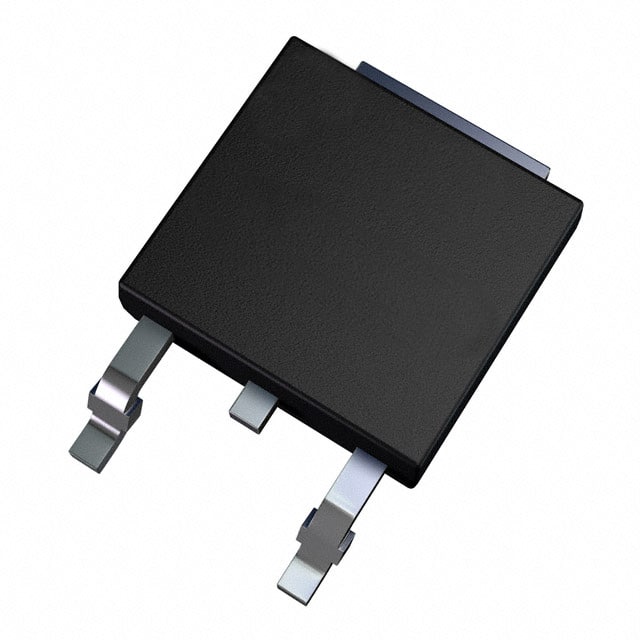2SD1805F-TL-E
Product Overview
Category:
The 2SD1805F-TL-E belongs to the category of semiconductor devices.
Use:
This product is commonly used as a power transistor in electronic circuits.
Characteristics:
- High voltage capability
- Low collector-emitter saturation voltage
- Fast switching speed
Package:
The 2SD1805F-TL-E is typically available in a TO-220F package.
Essence:
This product serves as a crucial component in power supply and amplification circuits.
Packaging/Quantity:
It is usually packaged in reels or tubes, with quantities varying based on manufacturer specifications.
Specifications
- Collector-Base Voltage (VCBO): 700V
- Collector Current (IC): 3A
- Power Dissipation (PD): 30W
- Transition Frequency (fT): 20MHz
- Operating Temperature: -55°C to 150°C
Detailed Pin Configuration
The 2SD1805F-TL-E features a standard TO-220F pin configuration: 1. Base 2. Collector 3. Emitter
Functional Features
- High voltage capability allows for use in various power applications.
- Low collector-emitter saturation voltage ensures efficient operation.
- Fast switching speed enables quick response in switching circuits.
Advantages and Disadvantages
Advantages
- High voltage capability
- Low saturation voltage
- Fast switching speed
Disadvantages
- Limited current handling capacity compared to higher-rated transistors
- Sensitive to overvoltage conditions
Working Principles
The 2SD1805F-TL-E operates based on the principles of bipolar junction transistors, where controlled current amplification and switching are achieved through the manipulation of minority charge carriers within the semiconductor material.
Detailed Application Field Plans
Power Supply Circuits
The 2SD1805F-TL-E is commonly used in power supply circuits due to its high voltage capability and low saturation voltage, enabling efficient power conversion.
Audio Amplifiers
In audio amplifier circuits, this transistor facilitates signal amplification with its fast switching speed and moderate current handling capacity.
Switching Circuits
Its fast switching speed makes it suitable for use in various switching circuits, including motor control and lighting applications.
Detailed and Complete Alternative Models
- 2SD1805G-TL-E
- 2SD1805H-TL-E
- 2SD1805J-TL-E
These alternative models offer similar characteristics and performance, providing flexibility in design and sourcing options.
In conclusion, the 2SD1805F-TL-E is a versatile power transistor with high voltage capability, making it suitable for a wide range of applications in power supply, amplification, and switching circuits.
[Word count: 413]
Lista 10 Vanliga frågor och svar relaterade till tillämpningen av 2SD1805F-TL-E i tekniska lösningar
Sure, here are 10 common questions and answers related to the application of 2SD1805F-TL-E in technical solutions:
What is the maximum collector current (IC) of 2SD1805F-TL-E?
- The maximum collector current (IC) of 2SD1805F-TL-E is 3A.
What is the maximum collector-emitter voltage (VCEO) of 2SD1805F-TL-E?
- The maximum collector-emitter voltage (VCEO) of 2SD1805F-TL-E is 50V.
What is the power dissipation (PD) of 2SD1805F-TL-E?
- The power dissipation (PD) of 2SD1805F-TL-E is 1W.
What are the typical applications of 2SD1805F-TL-E?
- 2SD1805F-TL-E is commonly used in audio amplifiers, power management circuits, and general switching applications.
What is the maximum junction temperature (Tj) for 2SD1805F-TL-E?
- The maximum junction temperature (Tj) for 2SD1805F-TL-E is 150°C.
What is the gain (hFE) of 2SD1805F-TL-E?
- The gain (hFE) of 2SD1805F-TL-E typically ranges from 60 to 320.
Is 2SD1805F-TL-E suitable for high-frequency applications?
- No, 2SD1805F-TL-E is not recommended for high-frequency applications due to its lower transition frequency.
What are the recommended operating conditions for 2SD1805F-TL-E?
- The recommended operating conditions for 2SD1805F-TL-E include a collector current (IC) of 1A, a collector-emitter voltage (VCE) of 5V, and a base current (IB) of 0.2A.
Can 2SD1805F-TL-E be used in automotive applications?
- Yes, 2SD1805F-TL-E can be used in automotive applications such as electronic control units (ECUs) and power management systems.
What are the key differences between 2SD1805F-TL-E and similar transistors?
- The key differences between 2SD1805F-TL-E and similar transistors include its specific maximum ratings, gain characteristics, and thermal resistance properties.
I hope these questions and answers provide helpful information for the application of 2SD1805F-TL-E in technical solutions. Let me know if you need further assistance!


